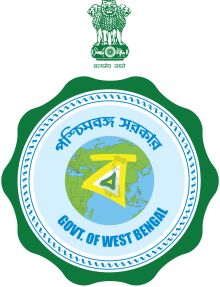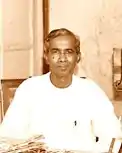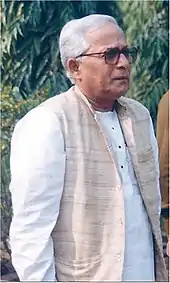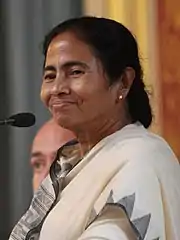List of chief ministers of West Bengal
The Chief Minister of West Bengal is the chief executive of the eastern Indian state of West Bengal. In accordance with the Constitution of India, the governor is a state's de jure head, but de facto executive authority rests with the chief minister. Following elections to the West Bengal Legislative Assembly, the state's governor usually invites the party (or coalition) with a majority of seats to form the government. The governor appoints the chief minister, whose council of ministers are collectively responsible to the assembly. Given the confidence of the assembly, the chief minister's term is for five years and is subject to no term limits.[3]
| Chief Minister of West Bengal | |
|---|---|
 | |
| Style | The Honourable (Formal) Ms. Chief Minister (Informal) |
| Status | Head of Government |
| Abbreviation | CM |
| Member of | West Bengal Legislative Assembly |
| Reports to | Governor of West Bengal |
| Residence | Chief Minister Abas, Kolkata[1] |
| Seat | Writers' Building, Kolkata[lower-alpha 1] |
| Appointer | Governor of West Bengal |
| Term length | At the confidence of the assembly Chief minister's term is for five years and is subject to no term limits.[3] |
| Inaugural holder | Prafulla Chandra Ghosh |
| Formation | 15 August 1947 (as Prime Minister of West Bengal) |
In August 1947, the British Indian province of Bengal was partitioned into the Pakistani province of East Bengal and the Indian state of West Bengal. Since then West Bengal has had eight chief ministers, starting with Prafulla Chandra Ghosh of the Indian National Congress (INC) party. His five-month stint as Prime Minister of West Bengal—as the office was known until January 1950[4]—was succeeded by the 14-year reign of colleague Bidhan Chandra Roy, whose death in 1962 led to Prafulla Chandra Sen serving out the remainder of his term. A period of political instability followed—West Bengal witnessed three elections, four coalition governments and three stints of President's rule between 1967 and 1972—before Siddhartha Shankar Ray of the INC served a five-year term.[5]
The landslide victory of the Communist Party of India (Marxist)-led Left Front in the 1977 election began Jyoti Basu's 23-year continuous reign as chief minister. The length of his tenure was an all-India record until 2018, when he was surpassed by Sikkim's Pawan Kumar Chamling.[6] Basu's successor Buddhadeb Bhattacharya continued Communist rule in West Bengal for another decade, when the Left Front was defeated in the 2011 election by the Trinamool Congress-led United Progressive Alliance (UPA). Sworn in on 20 May 2011, Trinamool leader Mamata Banerjee is West Bengal's incumbent chief minister, the first woman to hold the office. In September 2012 her party quit the UPA, and went on to contest the 2016 election alone, returning to power with an increased mandate.[7][8]
Chief Ministers of West Bengal
| Colour key for parties |
|---|





| No. | Name | Tenure[9] | Duration | Assembly (election) |
Party[5] | ||
|---|---|---|---|---|---|---|---|
| 1 | Prafulla Chandra Ghosh | 15 August 1947 | 22 January 1948 | 160 days | Provincial Assembly (1946–52)[lower-alpha 3] (January 1946 election) |
Indian National Congress | |
| 2 | Bidhan Chandra Roy | 23 January 1948 | 25 January 1950 | 2 years, 2 days | |||
| No.[lower-alpha 4] | Name Constituency |
Tenure[lower-alpha 5] | Duration | Assembly[10] (election) |
Party[5] (alliance) | ||
|---|---|---|---|---|---|---|---|
| 2 | Bidhan Chandra Roy Bowbazar[lower-alpha 6] |
26 January 1950 | 30 March 1952 | 12 years, 156 days (total: 14 years, 158 days) |
Legislative Assembly (1946–52)[lower-alpha 7] (January 1946 election) |
Indian National Congress | |
| 31 March 1952 | 5 April 1957 | First Assembly (1952–57) (January 1952 election) | |||||
| 6 April 1957 | 2 April 1962 | Second Assembly (1957–62) (March 1957 election) | |||||
| 3 April 1962 | 1 July 1962 | Third Assembly (1962–67) (February 1962 election) | |||||
| 3 | Prafulla Chandra Sen[lower-alpha 8] Arambagh East |
9 July 1962 | 28 February 1967 | 4 years, 234 days | |||
| 4 | Ajoy Kumar Mukherjee Tamluk |
1 March 1967 | 21 November 1967 | 265 days | Fourth Assembly (1967–68) (February 1967 election) |
Bangla Congress (United Front) |
|
| 5 | Prafulla Chandra Ghosh Jhargram |
21 November 1967 | 19 February 1968 | 90 days (total: 250 days) |
Independent (Progressive Democratic Front) |
||
| – | Vacant[lower-alpha 9] (President's rule) |
20 February 1968 | 25 February 1969 | 1 year, 5 days | Dissolved | N/A | |
| 6 | Ajoy Kumar Mukherjee Tamluk |
25 February 1969 | 16 March 1970 | 1 year, 19 days | Fifth Assembly (1969–70) (February 1969 election) |
Bangla Congress (United Front) |
|
| – | Vacant[lower-alpha 9] (President's rule) |
19 March 1970 | 30 July 1970 | 1 year, 14 days | N/A | ||
| 30 July 1970 | 2 April 1971 | Dissolved | |||||
| 7 | Ajoy Kumar Mukherjee Tamluk |
2 April 1971 | 28 June 1971 | 87 days (total: 2 years, 6 days) |
Sixth Assembly (1971) (March 1971 election) |
Bangla Congress (Democratic Coalition) |
|
| – | Vacant[lower-alpha 9] (President's rule) |
29 June 1971 | 20 March 1972 | 265 days | Dissolved | N/A | |
| 8 | Siddhartha Shankar Ray Malda |
20 March 1972 | 30 April 1977 | 5 years, 41 days | Seventh Assembly (1972–77) (March 1972 election) |
Indian National Congress (Progressive Democratic Alliance) |
|
| – | Vacant[lower-alpha 9] (President's rule) |
30 April 1977 | 20 June 1977 | 51 days | Dissolved | N/A | |
| 9 | Jyoti Basu Satgachhia |
21 June 1977 | 23 May 1982 | 23 years, 137 days | Eighth Assembly (1977–82) (June 1977 election) |
Communist Party of India (Marxist) (Left Front) |
|
| 24 May 1982 | 29 March 1987 | Ninth Assembly (1982–87) (May 1982 election) | |||||
| 30 March 1987 | 18 June 1991 | Tenth Assembly (1987–91) (March 1987 election) | |||||
| 19 June 1991 | 15 May 1996 | Eleventh Assembly (1991–96) (May 1991 election) | |||||
| 16 May 1996 | 5 November 2000 | Twelfth Assembly (1996–2001) (May 1996 election) | |||||
| 10 | Buddhadeb Bhattacharya Jadavpur |
6 November 2000 | 14 May 2001 | 10 years, 188 days | |||
| 15 May 2001 | 17 May 2006 | Thirteenth Assembly (2001–06) (May 2001 election) | |||||
| 18 May 2006 | 13 May 2011 | Fourteenth Assembly (2006–11) (April–May 2006 election) | |||||
| 11 | Mamata Banerjee Bhabanipur |
20 May 2011 | 25 May 2016 | 9 years, 258 days | Fifteenth Assembly (2011–16) (April–May 2011 election) |
All India Trinamool Congress[lower-alpha 10] | |
| 26 May 2016 | Incumbent | Sixteenth Assembly (2016–21) (April–May 2016 election) | |||||
See also
- List of Governors of West Bengal
- List of rulers of Bengal
- Prime Minister of Bengal
Footnotes
- Since October 2013 Chief Minister Banerjee has worked from the top floor of the newly constructed Nabanna building in Howrah, while Writers' undergoes renovation.[2]
- While the Assembly website calls the pre-1950 officeholders "Premiers of West Bengal",[9] the Times of India points out that they were universally referred to as "Prime Ministers of West Bengal" at the time.[4]
- This refers to the 90-member rump legislature that emerged following partition, representing the West Bengali constituencies of the erstwhile Bengal Legislative Assembly. It was constituted under the Government of India Act, 1935, not the Indian Constitution, which was still in the process of being drafted.[5]
- A number in parentheses indicates that the incumbent has previously held office.
- While the tenures have been primarily sourced to a list on the West Bengal Legislative Assembly website,[9] obvious errors (mainly around the 1969–71 period) have been corrected with the help of a historical essay from the same website.[5]
- Until March 1952, Roy did not represent any constituency. For his last three months in office, during the Third Assembly, Roy represented Chowringhee consistuency.
- Following the promulgation of the Constitution of India, the provincial assembly carried on as the legislative assembly of West Bengal until fresh elections could be organised in 1952.[5]
- According to some sources, Sen also acted as interim chief minister during 2–8 July 1962.[11]
- Under Article 356 of the Constitution of India, President's rule may be imposed when the "government in a state is not able to function as per the Constitution", which often happens because no party or coalition has a majority in the assembly. When President's rule is in force in a state, its council of ministers stands dissolved. The office of chief minister thus lies vacant, and the administration is taken over by the governor, who functions on behalf of the central government. At times, the legislative assembly also stands dissolved.[12]
- For the first 16 months Mamata Banerjee headed a coalition government that included ministers from Trinamool and the INC. After Trinamool quit the United Progressive Alliance in September 2012, INC members resigned from her ministry, which has consisted of only Trinamool members ever since.[7]
References
- Arshad Ali. "Mamata may move to new CM's residence — British-era bungalow". The Indian Express. 8 October 2013. Archived on 19 July 2014.
- Shiv Sahay Singh. "Mamata shifts office to Nabanna". The Hindu. 6 October 2013. Archived on 21 December 2016.
- Durga Das Basu. Introduction to the Constitution of India. 1960. 20th Edition, 2011 Reprint. pp. 241, 245. LexisNexis Butterworths Wadhwa Nagpur. ISBN 978-81-8038-559-9. Note: although the text talks about Indian state governments in general, it applies for the specific case of West Bengal as well.
- Saibal Sen. "Post-Independence, a Prime Minister for Bengal!". The Times of India. 15 August 2013. Archived on 16 July 2018.
- Origin and Growth of the West Bengal Legislative Assembly. West Bengal Legislative Assembly. Retrieved on 27 July 2018.
Note: In case of an error, please click the "Origin & Growth" button in the top left of the website. - "Pawan Kumar Chamling crosses Jyoti Basu’s record as longest-serving Chief Minister ". The Hindu. 29 April 2018.Archived on 31 July 2018.
- Shiv Sahay Singh. "Congress quits Mamata Ministry". The Hindu. 22 September 2012. Archived on 26 July 2018.
- Subrata Nagchowdhury. "Behind Mamata Banerjee’s landslide victory in Bengal, old ghosts versus new promise". The Indian Express. 20 May 2016. Archived on 26 July 2018.
- Premiers/Chief Ministers of West Bengal. West Bengal Legislative Assembly. Archive link from 12 March 2016.
- Brief Information on Previous Assemblies. West Bengal Legislative Assembly. Archive link from 12 March 2016.
- List of Chief Ministers of West Bengal. Panchayat & Rural Development Department, Hooghly. Retrieved on 27 July 2018. Archived on 27 July 2018.
- Amberish K. Diwanji. "A dummy's guide to President's rule". Rediff.com. 15 March 2005. Archived on 16 August 2017.
Further reading
| Wikimedia Commons has media related to Chief ministers of West Bengal. |
- "Left Front Government of Bengal: A Saga of Struggle" – a political history of West Bengal from the CPI(M)'s point of view
